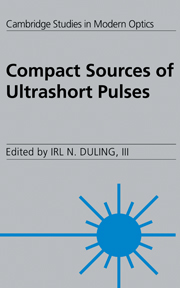Book contents
- Frontmatter
- Contents
- List of contributors
- Acronyms and abbreviations
- Preface
- 1 Short pulse generation
- 2 Passive modelocking in solid state lasers
- 3 Compact modelocked solid state lasers pumped by laser diodes
- 4 Modelocking of all-fiber lasers
- 5 Nonlinear polarization evolution in passively modelocked fiber lasers
- 6 Ultrafast vertical cavity semiconductor lasers
- 7 High power ultrafast semiconductor injection diode lasers
- 8 The hybrid soliton pulse source
- 9 Monolithic colliding pulse modelocked diode lasers
- Index
1 - Short pulse generation
Published online by Cambridge University Press: 20 January 2010
- Frontmatter
- Contents
- List of contributors
- Acronyms and abbreviations
- Preface
- 1 Short pulse generation
- 2 Passive modelocking in solid state lasers
- 3 Compact modelocked solid state lasers pumped by laser diodes
- 4 Modelocking of all-fiber lasers
- 5 Nonlinear polarization evolution in passively modelocked fiber lasers
- 6 Ultrafast vertical cavity semiconductor lasers
- 7 High power ultrafast semiconductor injection diode lasers
- 8 The hybrid soliton pulse source
- 9 Monolithic colliding pulse modelocked diode lasers
- Index
Summary
Introduction
Optical frequencies are so high that a small relative bandwidth is a very large bandwidth in absolute terms. This fact is behind the success of optical short pulse generation. The first successful generation of short optical pulses via modelocking started in the 60s with Nd:glass. Figure 1.1 gives the history of the advances in short pulse generation. Steady progress in generating shorter and shorter pulses was achieved with dye lasers, principally because these were CW lasers that had much more predictable modelocking behavior than Q-switched lasers. After subpicosecond pulse generation was achieved with dye lasers, it was soon realized that the short pulses produced by the lasers were much shorter than the relaxation times of the dyes used for the gain and absorption media. It was recognized that the pulses were generated through combined action of the saturable absorber dye that, by saturating, opened the ‘shutter’ for the transmission of the pulse, and the gain, by saturating, closed the ‘shutter.’ This was an important discovery since there exist very few saturable absorbers with subpicosecond relaxation times appropriate for intracavity operation. The shortest pulses achieved were 27 fs in duration, and after spectral spreading in a fiber and subsequent compression 6 fs was achieved, still the record today.
In 1978 the first modelocking of semiconductor lasers was achieved. They are of prime importance in communications applications and are limited to about 100 fs pulse duration, a pulse width adequate for communications for many years to come.
- Type
- Chapter
- Information
- Compact Sources of Ultrashort Pulses , pp. 1 - 56Publisher: Cambridge University PressPrint publication year: 1995
- 4
- Cited by



